Alan Wake – Xbox 360 review
Review by Johnus Maximus
 When the wife of bestselling novelist Alan Wake goes missing in a bizarre incident, he finds himself caught in a nightmare seemingly of his own making, struggling against mysterious forces whilst trying to unravel the mystery behind her disappearance.
When the wife of bestselling novelist Alan Wake goes missing in a bizarre incident, he finds himself caught in a nightmare seemingly of his own making, struggling against mysterious forces whilst trying to unravel the mystery behind her disappearance.
Alan Wake is a psychological action thriller developed by Remedy Entertainment and published by Microsoft Game Studios for the Xbox 360. Despite a contrived premise and unoriginal gameplay elements, it is a compelling single player experience.
The titular Alan is a successful but troubled writer, arrogant with his fame, stricken with writers block and beset by nightmares about his next novel. His wife and muse takes him on a retreat to Bright Falls, a small Pacific Northwestern town which she thinks is the perfect place for Alan to begin a process of creative recovery.
By day, the sedate and idyllic lifestyle of the Bright Falls townsfolk seems banal and uninteresting to Alan, but little does he know that there are mysterious supernatural forces at work in this town full of dark secrets. Once the horror of his wife’s disappearance begins, the daylight hours are the only respite he’ll have from the malevolent forces at work.
Story is intrinsic to the game, broken up into six episodes which last a little over ninety minutes depending on the amount on exploration you attempt. They begin with a plot recap akin to Lost or 24 and end either on a cliff-hanger or the resolution of a pivotal plot device. The absence of credits at the end of each episode is the only thing that detracts from the miniseries-like nature of the presentation.
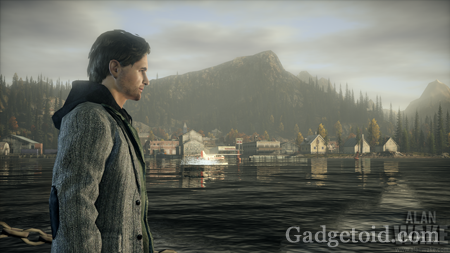
Welcome to Bright Falls, home of eerily named Cauldron Lake
There are an abundance of cut scenes in the game, and they are hampered by some truly terrible facial animations. Poor lip synching is always a bugbear of mine, and in this game it is extremely off putting. Also, the emotional expressions are on the wrong side of the uncanny valley detracting from the otherwise fine direction. I found the voice acting much more enjoyable, but due to the graphical issues I found the best lines were delivered by Alan when you are looking at the back of his head.
Outside of the cut scenes the graphical presentation is superb, it’s apparent that a great deal of work and rework has been done to create authentic environments, on more than one occasion I was reminded of Twin Peaks. Shadows moving in your peripheral vision could be nothing more than a swaying branch, but it puts you on edge as you wander about.
The gameplay itself is that of a third person shooter, you must guide Alan through a series of objectives that push the story onward. Along the way he will be besieged by three types of enemy – shadowy humanoid figures dubbed “The Taken”, armed with axes, saws and other hunter garb, invisible poltergeists that levitate or inhabit environmental objects, and flocks of bloodthirsty ravens, always hovering menacingly overhead.
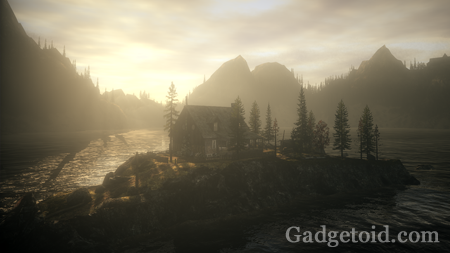 As the sun sets on Cauldron Lake, a growing darkness stirs
As the sun sets on Cauldron Lake, a growing darkness stirs
Alan has only a few pieces of weaponry with which to dispatch these foes, primarily a torch. Shining the beam in the direction of these shadowy enemies will slowly weaken them, holding the trigger will increase the intensity of the beam until you have vanquished them. In the case of The Taken, after removing their shadowy shield, you must then use a physical weapon to finish them off.
Fortunately for Alan, the trusting townsfolk almost never leave their guns and ammo locked up, so as you travel through farms, quarries, police stations and the other assorted environs you can usually pick up something to use. In addition, someone (it is revealed later in the game) has been leaving secret stashes of light based weaponry – flares and flash-bang grenades – as well as spare packs of batteries.
The absence of a melee attack means that if you drain the torch batteries too quickly or waste the scant supply of ammunition provided, you’ll have to dodge the enemy attacks and run away to a brightly lit safe haven, be it a streetlight, the headlights of a car or a well lit room. These areas act as checkpoints, and allow you to catch your breath, recharge your battery and recuperate your health before attempting to continue.
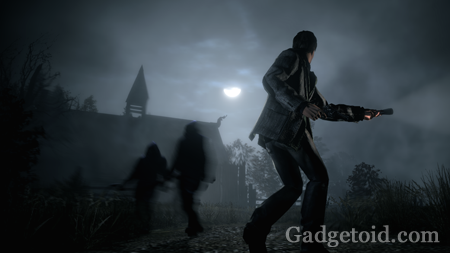 When danger reared its ugly head he bravely turned his tail and fled
When danger reared its ugly head he bravely turned his tail and fled
There’s a certain amount of repetition in the enemy attack patterns and I got the impression that they were designed to drive you toward your goals, rather than impede your progress. Puzzle solving, a staple of the survival horror genre, is present in Alan Wake but only at a very rudimentary level. The majority of your head scratching will come from the collectible manuscript pages scattered throughout the levels.
As you come across these pages, you’re given small glimpses of parts of the story that have yet to unfold. At times this can confuse you, but it also helps create a different kind of tension from the usual “boo here’s the monster” moments, and instead leave you wondering when and indeed if these events are going to happen.
I mentioned previously that the story is told over a series of episodes, and for the most part I found the pacing to be excellent. The tension is built steadily, with a few moments of calm listening to the late night talk radio station on the scattered radios you find and also some comedic relief at the expense of Alan’s agent Barry (a stereotypical New Yorker) before setting off once more onto the thrill ride that it is.
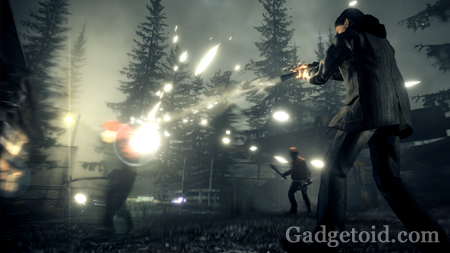 Enemies require a two pronged attack, first with light then with projectiles
Enemies require a two pronged attack, first with light then with projectiles
Throughout the play through, I felt that the plot and characters are jarringly full of clichés – the obsessive fan, the over-zealous FBI agent, the perversely friendly psychiatrist and the deranged old lady who knows too much. We’ve seen so many versions of these characters in films, books and TV before that it’s easily construed as laziness on the part of the writers.
After finishing the game and having spent some real time pondering the nature of the plot I have come to realise that Remedy have meticulously crafted these overused stereotypes on purpose. Without giving too much away about the games conclusion, it does become clear that these clichés exist for a very specific reason and kudos to them, it had me fooled.
I’m glad that the developers abandoned the notion of making this game an open world, as the driving sections that have made it into the final game are absolutely woeful. I also think it would have been interesting to see the game released on an episodic basis, rather than in this “DVD box set” style, as the temptation to continue playing it once you’ve reached the end of an episode is all too compelling, and so the experience over rather quickly.
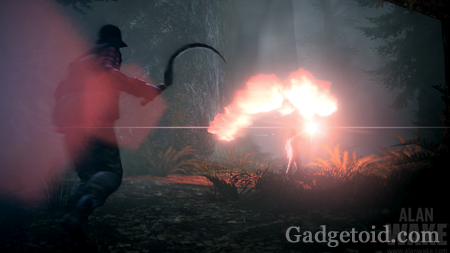 Flares afford you a temporary reprieve from the dark foes attacking Alan
Flares afford you a temporary reprieve from the dark foes attacking Alan
The short nature of the game, coupled with the interspersed collectibles, means that it is certainly feasible to replay it multiple times. The first completion will unlock the Nightmare difficulty, in which some of the manuscripts can only be found. What revelations they reveal is unclear to me at this time, but there’s certainly reason to revisit the game if you enjoyed it first time around.
With such a long development time, there has been plenty of hype built up about Alan Wake and I don’t feel that it lives up to it all, it’s by no means the game changing title that Microsoft had led some people to believe. Despite the cut scene issues and the overly repetitive gameplay, it is, however, a competent and enjoyable supernatural thriller, the interplay between light and dark is an excellent mechanic and the overall presentation is commendable.
Alan Wake scores four (out of five) stars.
